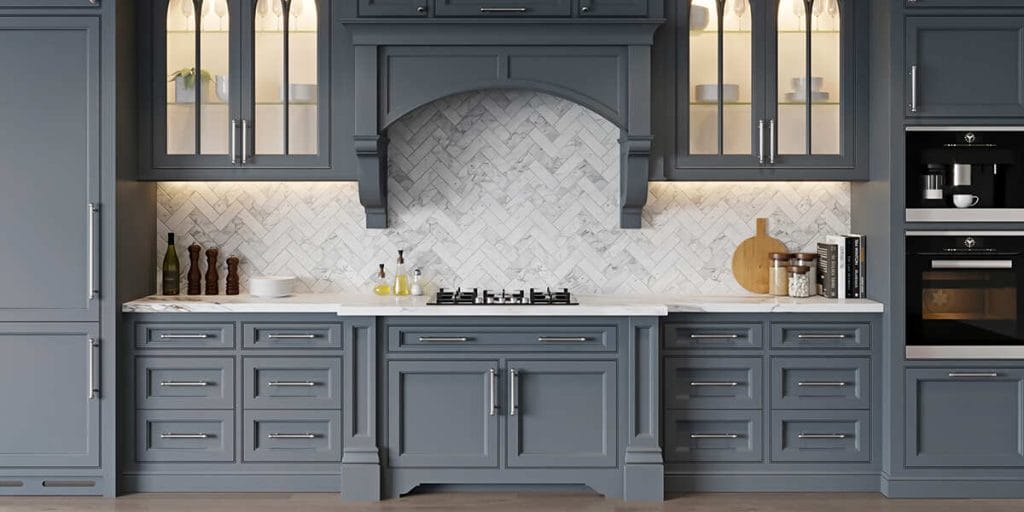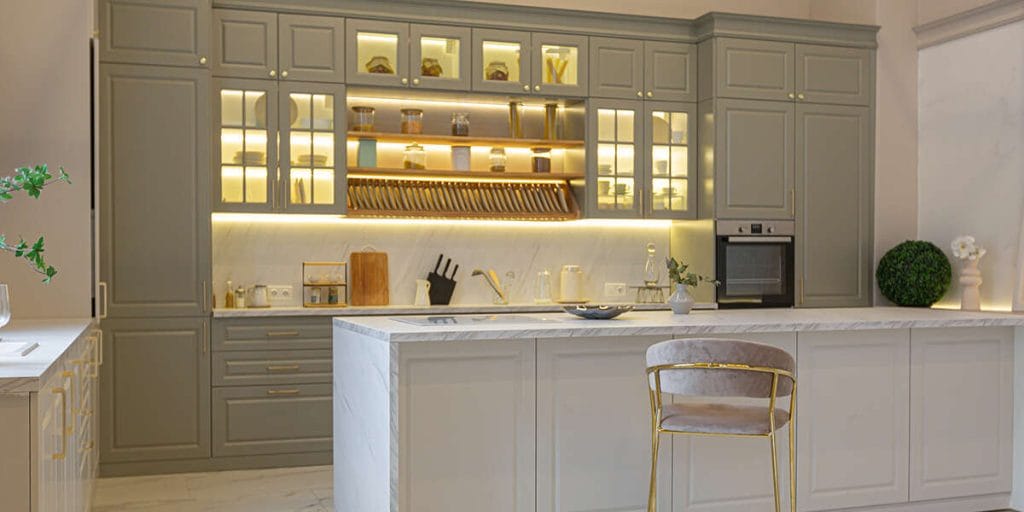What Are Shaker Cabinets Made Of?

What Are Shaker Cabinets Made Of? Kitchens and bathrooms require durable cabinets to withstand humidity and spills from cosmetics, water, and chemical cleaners. Kitchens are also high-traffic areas, so pots, pans, and other items could knock against the cabinets by accident. When choosing between cabinet styles, you need to pick ones that have the potential to last a long time without replacements. Shaker cabinets can be a good choice — but what are Shaker cabinets made of, and how well can they withstand kitchen, bathroom, and storage hazards? Since Viteri Cucine provides luxurious kitchen remodeling services in Hollywood, FL, our team knows which styles work well with each room. Read more to learn which materials many manufacturers use to build Shaker-style cabinets. A Brief History of Shaker Cabinets Shaker-style cabinets got their name from the Shakers, a religious group that immigrated to North America in the 1700s and broke off from the Quakers. They value simplicity, which they emulate in their handiwork. The doors on Shaker cabinets have two short rails inside of two longer stiles with a recessed center panel. The traditional door frame doesn’t have extra ornaments or edging, sticking to clean lines and utility. Since they began producing and selling this style, the Shaker-style kitchen cabinet has become a mainstay in many traditional and modern kitchens. Its simplistic, timeless design makes it a popular choice for kitchens, bathrooms, and other spaces no matter what other aesthetic choices homeowners make. Four Best Shaker Cabinet Materials According to trending kitchen remodel facts for 2024, remodeling costs are rising. Therefore, you would want any cabinets you install to either last a long time or be easy to replace. So, what are Shaker cabinets made of, and how can they stand up to the test? Solid Wood Considering its long history, all previous Shaker-style products came from natural wood. High-quality solid wood, like cherry, oak, and maple, have been popular wood types for Shaker cabinets and drawers. The simplistic design helps emphasize the beauty of the natural grain, and the wood’s strength enhances the cabinet’s durability. Plywood Solid wood can be expensive, so you can consider plywood as a lower-cost substitute. Not only can you make plywood look like solid wood with veneers, but plywood also tends to be more water-resistant than its competitors. Plywood works perfectly in bathrooms, which tend to be one of the most moisture-dense areas in a household. Medium-Density Fiberboard (MDF) MDF comes from recycled wood fibers, wax, and resin that manufacturers heat-treat and smooth into a flat surface. It can be harder to mimic wood grain on MDF, but the material works well for Shaker-style cabinets. Because its composition uses recyclable items, MDF tends to be more sustainable than wood, though you sacrifice some water resistance and durability. Particle Board Along the same lines as MDF and plywood, particle board uses wood chips and synthetic resin, making it slightly less sustainable. However, this option is typically the least expensive when considering the question, “What are Shaker cabinets made of?” While less durable and prone to moisture damage, they still work well for cabinet boxes, allowing for more sturdy doors and face frames. Design Your Favorite Cabinets Today Viteri Cucine offers high-quality custom cabinets for installation in your kitchen, vanity, or closet. We pride ourselves on our manufacturing expertise, designing prowess, and friendly customer service, ensuring you get the most out of our care. Call 954-549-4912 or visit our contact page to schedule your free consultation today. FAQs About Shaker Cabinets How much do Shaker cabinets cost? The cost for your Shaker cabinets depends on several factors, including the materials, the labor costs, and the hardware on the cabinets. Always ask for a free quote on any custom cabinetry designs you request to ensure you stay within your budget. Is there only one style for Shaker cabinets? No, there is more than one style for Shaker cabinets, which now include beadboard and decorative edging while keeping the clean lines that made them popular. While you may face some customization limits, ask your designer how you can make Shaker cabinets fit your aesthetic. What is the best countertop material for Shaker cabinets? There is no “best countertop material” for modern Shaker cabinets. Because of the clean and simplistic design, you can choose just about any type of countertop. Shaker cabinets work well as a background canvas to nearby elements, contributing aesthetic appeal via color and clean design work but being mute enough to let other features take the spotlight. After asking, “What are Shaker cabinets made of?” and choosing the right material, you can start determining which countertops you want in your kitchen, closet, or vanity.
Are Shaker Cabinets in Style?

Are Shaker Cabinets in Style? Home decoration fads come and go, so choosing between cabinet styles can be exceptionally difficult. Are Shaker cabinets in style as of the 2020s, or have they aged out? As a top-quality kitchen remodeling company in Hollywood, FL, Viteri Cucine experts keep the pulse on worldwide trends, including cabinet aesthetic developments. Here’s our verdict on Shaker-style cabinets. A Quick Cabinet Glossary for You Our cabinet industry professionals use a few terms you may not hear often. While we don’t list every term, these should be able to get you through the article. Cabinets typically have three main components–a box, a door, and drawers–as well as the following components: Face Frame The face frame refers to the open portion at the front of the cabinet box. The frame has pre-formed spaces for the doors and shelves that are already in place for easier installation. Manufacturers often make frames out of more sturdy materials, so the box may be plywood or vinyl, but the frame could be hardwood. Frameless Box A frameless cabinet box does not have a face frame. Instead, the door connects directly to the body of the cabinet. If the frameless cabinet has a drawer, manufacturers pre-install a support inside the cabinet to allow it to move. Rails and Stiles Rails are the horizontal frames for some cabinet doors and cabinet box faces. Stiles refer to the vertical frames. Together, they make a square or rectangular form on which you can attach a cabinet door. Center Panel A center panel sits in the middle of the cabinet door’s rails and stiles and usually comes flat or raised. Raised panels can come in various sizes and beveling angles. Frameless doors only have a center panel and will not have stiles or rails. Edge Profile The rails and stiles of the cabinet door can have stylized shapes, including classical curves and bevels. These alterations, or edge profiles, help set the aesthetic of the room. The question of, “Are Shaker cabinets in style,” largely depends on what you want from design aspects like these. What Are Shaker Cabinets? The Shakers, a subset of the Quakers, largely immigrated from England and other nearby countries to North America in the 1700s. They valued simplicity and efficient construction without unnecessary elements as a part of their lifestyle. This early form of minimalism extended into their products, too, serving as a major source of income for their villages. Shaker-style cabinets have a cope-and-stick construction for the door, using two short rails, two long stiles, and a recessed panel in the middle. The rails and stiles attach without any diagonal cuts. Its rails usually connect to the inner sides of the stiles. The cabinet doors in the Shaker category lack carvings, ornamental flourishes, or other designs. Instead, the Shaker cabinets are known for their simplistic geometric shape, a prominent element in many a traditional kitchen. A Modern Adaptation on Shaker Kitchen Cabinets With new technology and construction knowledge, manufacturers have simplified Shaker kitchen cabinets a lot. Instead of separate rails and stiles, designs now cut out a single rectangular frame. This modern adaptation gives the already simplistic Shaker-style kitchen cabinet a more sleek, clean-cut appearance. The Pros and Cons of Shaker-Style Cabinets The statistics on home renovation seem to indicate that redesign costs are increasing. When you make a cabinet decision, make it a good one. Are Shaker cabinets in style with great benefits, or are they on their way out? Here are the pros and cons. Pros of Shaker Cabinets Homeowners, landlords, and installers indicate that Shaker cabinets have these benefits: Low cost. Shaker cabinet doors have never been exceptionally expensive to build, even with more high-quality materials. Best as a canvas. These doors tend to draw less attention, so you can show off other features, like the backsplash, countertops, or hardware. Easy on the eyes. Because the door is light on design features, it blends well into the space, producing a more open feel. Design flexibility. This door style lends well to many colors and materials, making it versatile for any kitchen, bathroom, or storage room. High resale value. Home renovation research shows that quality Shaker cabinets suit many households, enhancing how easily you’ll resell your property. Easy coordination. The simplistic design means you can match this door style with almost any other door you want, so wall and floor cabinets can have different doors. Cons of Shaker Cabinets Shaker-style cabinets have also gotten some unflattering feedback. Some pain points might include the following: Limits on the finish. Decorative glazes don’t sit well on the firm, straightforward style of a Shaker cabinet. Wrong presentation. Those who want a more stately kitchen or bathroom sometimes note that Shaker cabinets seem too casual for their tastes. A focus on accuracy. Because the door has a boxy shape, it can be easy to note any inaccuracies in its design, like alignment issues or uneven manufacturing. Some color limitations. Certain, bolder colors accentuate the edge profiles and curves of a cabinet door. Shaker cabinets have fewer curves, which sometimes dulls the presentation. Too light on decoration for homebuyers. The lack of ornate detail makes the space appear too plain for some prospective buyers. Room design limitations. Frameless Shaker cabinets with thin rails and stiles can make a small space look cramped. Overall Verdict: Shakers Are In Are Shaker cabinets in style with the general populace? Shaker cabinet doors have been in style since the 18th century and show no sign of going out yet. With a timeless design, easy-to-manufacture frame, and a composition that lends itself well to framed and frameless cabinets, Shakers are here to stay. What do you want out of your kitchen cabinets? You can feel comfortable putting these cabinets in any space, from storage to kitchens, and with traditional designs or as modern Shaker cabinets. The doors serve well as a canvas for any other elements you want to emphasize, so they’re team players in the aesthetics department. Since you
